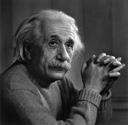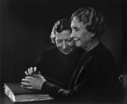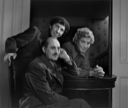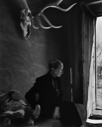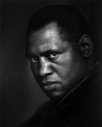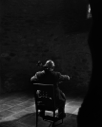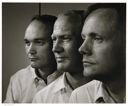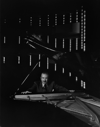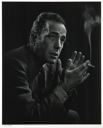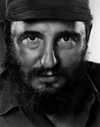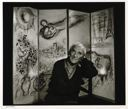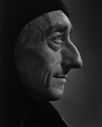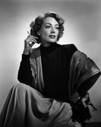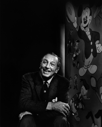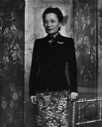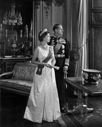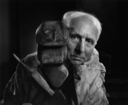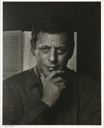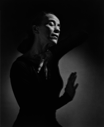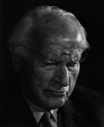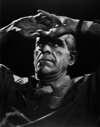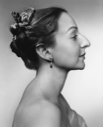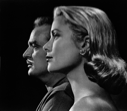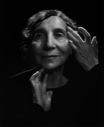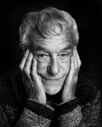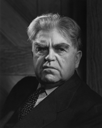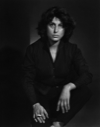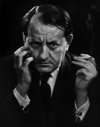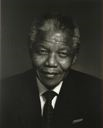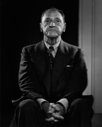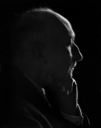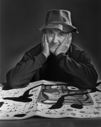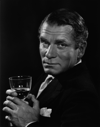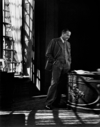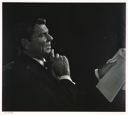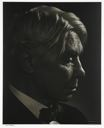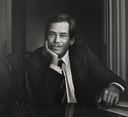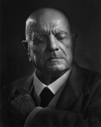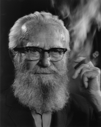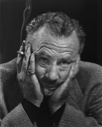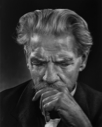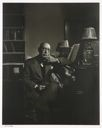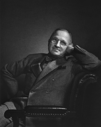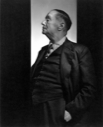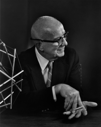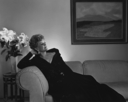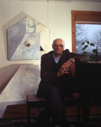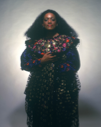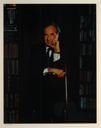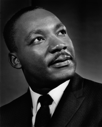Yousuf Karsh
Canadian, born Armenia
(Mardin, Armenia, 1908 - 2002, Boston, Massachusetts)
Karsh was born in Turkish Armenia. At age 12, he escaped the Armenian genocide by walking for days through the desert with his parents and two younger siblings to Syria. In Aleppo he attended the American Mission School until invited to assist his uncle George Nakash (Canadian, born Armenia, 1892–1976) in his photography studio in Sherbrook, Quebec, Canada. He docked in Halifax, Nova Scotia penniless on New Year’s Eve in 1925 and embarked on a new life. His hard work, good manners, and instinctive ability to ingratiate himself with portrait subjects soon led to financial and critical success. He was the only photographer on the International Who’s Who list of 100 people compiled from their 1935 through 1999 editions—a list that included 51 individuals he had photographed. (1) Karsh became the most prominent portrait photographer of his time. After apprenticing with Nakash, he assisted John Garo (active Boston, Massachusetts; 1875–1939). He studied the art of Rembrandt and learned to use natural light to sculpt his subjects’ forms against dark backgrounds. By 1932, when he opened his own studio in Ottawa, he had mastered the complexities of large-format black-and-white photography. He soon added artificial lighting to his repertoire through work in the Ottawa Little Theatre with dancer Solange Gautier (1900–1961), who would become his first wife in 1939. (2) From the start of his career, Karsh produced perfect prints in his darkroom making the most of the 8 x 10 inch negatives from his trademark white Calumet camera. (3) However, it was his technique in the camera room that made his fame. The affable and impeccably dressed artist put his subjects at ease with casual conversation until they relaxed their pretensions and revealed their true personalities. Then he clicked the shutter once or twice, capturing what he called “the inward power” of his subjects. (4) In 1951, Karsh expressed his intent “to tell the truth in terms of beauty.” (5) He sought to convey the best aspects of his subjects on film. His artistic quest was “a search for a form in which he could evoke a symbol of a person whose essence was directed toward making life seem purposeful and good.” (6) Consequently, politicians, celebrities, and other luminaries sought his services. He photographed every American president from Eisenhower through Clinton, plus the heads of state of Canada, Great Britain, France, and many other nations, as well as several popes. The J. Walter Thompson advertising agency contracted for portraits of Hollywood stars. (7) Mid-century pictorial magazines like Life and Look published his pictures, and Karsh authored a dozen books of his portraits accompanied by anecdotes about the subjects or the sittings. (8) Authors, artists, dancers, composers, architects, activists, humanitarians, scientists, and singers were grateful for the opportunity to be “Karshed,” as the jargon for his iconic image production came to be known. Some subjects initiated the process while others simply granted the humble photographer’s request for a sitting. Some of Karsh’s subjects begrudged the artist their time and attention. Karsh was disappointed that the artist Pablo Picasso (1881–1973) spent a mere twenty minutes with him. The photographer’s most challenging and most rewarding portrait resulted from even less time with Winston Churchill (1874–1965), Great Britain’s bulldog of a prime minister. (9) A photo session had been squeezed into Churchill’s schedule immediately after his address to the Canadian House of Commons on December 30, 1941 (just three weeks after Pearl Harbor), yet he was surprised to find Karsh awaiting him, camera and lights at the ready. He bruskly granted two minutes for one photo. Karsh asked him to remove his ubiquitous cigar and when he did not, the photographer stepped forward and respectfully removed it for him, having decided in advance that the man needed no props. When Karsh returned to the camera and saw Churchill scowling, he instinctively released the shutter. Churchill realized he’d been “Karshed,” smiled, and said, “you may take another.” Karsh did, but Churchill’s saccharine smile in it does not compare with the first portrait (MMFA 1996.5.2), which soon appeared in Life magazine and countless other periodicals, becoming emblematic of all England’s fierce grit and fortitude. (10) In the years following his landmark Churchill portrait the rich and famous lined up to be “Karshed” in the photographer’s flattering, signature style. The artist fixed on film the delicate beauty of Audrey Hepburn (1956, MMFA 2013.5.26) and the rugged good looks of Clark Gable (1948, MMFA 2013.5.20). He pictured the poise of contralto Marian Anderson (1945, MMFA 2013.5.1) humming quietly after he secretly asked her accompanist to play one of her favorite songs. (11) He found the phenomenal light that he said “comes from within” in the face of the blind, deaf, and mute Alabamian, Helen Keller (1948, MMFA 1996.5.5). In his double portrait of Keller and her assistant, Polly Thompson, Karsh highlighted their hands and faces against a somber background, remarking that Keller’s hands created light out of darkness. (12) Likewise, when he photographed Eleanor Roosevelt in 1945 (MMFA 1996.5.10), he noted, “her hands are among the most eloquent I have ever seen.” (13) Karsh, of course, had seen a lot of hands. Hers, he said, “seemed somehow to reveal the woman herself… [so he] allowed Mrs. Roosevelt’s hands to act out, as it were, their natural part in her personality…. I watched them as carefully as I watched the face and when their gesture seemed to fit exactly the expression I quickly made the exposure.” (14) At the peak of his prowess in 1954, the artist, his wife, and an assistant sailed from New York to Le Havre, France, with 34 pieces of luggage and Karsh’s Chrysler. They worked hard and played hard. The assistant drove, set up equipment, and helped in the darkroom. Solange managed schedules and communications, chatted with subjects while the stage was set, and recorded notes about the sittings for photo captions that were written later. Karsh commanded the operation and processed his film in hotel bathrooms in the middle of the night. He quickly established rapport with those in the lights through conversation and careful listening. Photo sessions lasted from a few minutes with Picasso to all day with Albert Schweitzer (MMFA 2013.5.61). (15) Authors were among Karsh’s favorite subjects, and he felt a special affinity with artists because they understood the creative process. He also enjoyed musicians and singers because they were impatient and temperamental, qualities that captivated him. Karsh lived and worked in an international Western culture that venerated greatness throughout the middle of the twentieth century. He captured that historical moment on film, creating iconic portraits of the most heroic men and women of the era. By the time of his retirement in 1992, more than 15,000 people had been the subject of his portraits. Karsh made his reputation by making the iconic images of household names, but not all of his sitters were famous. Through much of his career, he maintained studios in Ottawa, New York City and Washington, D.C., although his base of operations was always the Canadian capital city and no single photograph of his ever surpassed the impact of the portrait of Churchill that he made there. (16)
(1) Prior to the escape to Syria, Karsh’s three older siblings had died from starvation and disease. See Maria Tippett, "Portrait in Light and Shadow: The Life of Yousuf Karsh" (New Haven: Yale University Press, 2007). Karsh’s autobiography is "In Search of Greatness, Reflections of Yousuf Karsh" (New York: Alfred A. Knopf, 1962). Recent surveys of the artist and his work are: Yousuf Karsh and Jerry Fielder, "Karsh: A Biography in Images" (Boston: Museum of Fine Arts, Boston, 2003); and David Travis and Patricia Kouba, "Yousuf Karsh: Regarding Heroes" (Boston: David R. Godine, 2009). The National Archives of Canada is the repository of the artist’s papers, a massive collection of textual and visual materials. A copy of relevant portions of "The International Who’s Who" (London: Europa Publications Limited, 1999) is in the MMFA artist file.
(2) Gautier died of cancer. Karsh married Estrellita Nachbar in 1962. Both women worked closely with Yousuf, helping to manage the business and interact with clients.
(3) In his heyday, Karsh used an 8 x 10 inch view camera with a 14-inch Kodak Ektar lens, six floodlights, two spotlights, and a background light. He shot Super XX Panchromatic film, usually at 1/10 of a second (Tippett, 139-142). See also Karsh, "Portraits of Greatness" (Toronto: University of Toronto Press, 1959), 207.
(4) For Karsh's discussion of “the inward power,” see "In Search of Greatness," 94.
(5) Tippett, 130. As Karsh’s long-time assistant, Jerry Fielder, wrote to the MMFA in 2008 (copy in artist file), “Yousuf was a man who genuinely sought, and found, the best in people--their strength, their compassion, their determination, their tenderness. He didn’t make Helen Keller inspirational; he didn’t make Fidel Castro determined; he didn’t make Pope John Paul II compassionate; and he didn’t give Albert Schweitzer inner strength. He brought out what was already there. He looked for the truth, drew it from his subjects, and then shared it with us.”
(6) Travis and Kouba, 38.
(7) Hollywood studios commissioned most of Karsh’s portraits of actors. In 1948, he doubled his prior-year profits through contracts with J. Walter Thompson, then the largest advertising agency in North America, and by publishing pictures in high-paying magazines like Life (Tippet, 215). In the mid-1940s, Karsh routinely received $300 for a portrait sitting and about $400 for a set of prints plus travel expenses, but he charged about a third less for studio portraits in Ottawa, and he discounted his fees further for residents of that city.
(8) In his many books, Karsh accompanied his photographs with captions that described the subject, the setting, and anecdotes of the portrait sitting. That prose was part of his art, just as conversation and careful listening were essential parts of the process that revealed the distinctive character of his camera fodder. In addition to "In Search of Greatness" and "Portraits of Greatness," Karsh published "Faces of Destiny: Portraits by Karsh" (Chicago and New York: Ziff-Davis, 1946); with John Fisher, Yousuf Karsh and John Fisher "See Canada" (Toronto: Thomas Allen, 1960); "Karsh Portfolio" (Toronto: University of Toronto Press, 1967); "Faces of Our Time" (Toronto: University of Toronto Press, 1971); "Karsh Portraits" (Toronto: University of Toronto Press, 1976); "Karsh Canadians" (Toronto: University of Toronto Press, 1978); "Karsh: A Fifty-Year Retrospective" (Toronto: University of Toronto Press, 1983); "Karsh: American Legends: Photographs and Commentary" (Boston: Bulfinch Press, Boston, 1992); "Karsh: A Sixty-Year Retrospective" (Boston: Bulfinch Press, 1996). He also published several books about Catholicism with Bishop Fulton J. Sheen: "This is the Mass" (New York: Hawthorne Books, 1958); "This Is Rome: A Pilgrimage in Words and Pictures" (New York: Hawthorn Books, 1959); "This is the Holy Land: A Pilgrimage in Words and Pictures" (New York: Hawthorn Books, 1961); and "These Are the Sacraments: As Described by Bishop Fulton J. Sheen and Photographed by Yousuf Karsh" (New York: Hawthorn Books, 1962).
(9) Churchill (1874–1965) was the son of Lord Randolph Churchill and Jennie Jerome, an American. He was educated at Harrow and Sandhurst, served in the Boer War and World War I, and entered Parliament in 1900. His active and often controversial political career culminated in his becoming Prime Minister in 1940, at the most dire moment in Great Britain’s history. With dogged determination and boundless energy he rallied his nation and led it to victory in World War II. He served as his country's Prime Minister 1940–1945 and again 1951–1955.
(10) Tippett, 137-148.
(11) The concert artist was noted for her graceful and restrained movement on stage. When Karsh photographed the contralto at her home and studio in Danbury, Connecticut she was near the peak of her career. In 1939 she had performed an Easter concert at the Lincoln Memorial for 75,000 people and a national radio audience after being denied her request to book Constitution Hall, the premier performance hall in the segregated capital city. Anderson had performed throughout Europe and America in the 1930s, often battling racial discrimination in the U.S. She eventually performed in Carnegie Hall, The White House, and the Metropolitan Opera (1955)—their first black singer.
(12) Karsh also said, “I knew that my ideal picture would have to include not only that luminous, serene, yet vivid face, but those sensitive hands, together with the devoted concentration of her companion. To keep all these elements in the right proportion would be a challenge. I felt I must try, too, to transmit something even beyond this—the importance of her tremendous victory for humanity. Only a very insensitive person could leave Helen Keller’s presence without feeling hope for humanity and faith in the Infinite. I hoped that I could produce a portrait that would convey her message to her fellow humans.” ("In Search of Greatness," 126.)
(13) "Faces of Destiny," 126.
(14) "Portraits of Greatness," 166. The wife of Franklin Delano Roosevelt bolstered her husband’s political career, serving as mobile eyes and ears after disease paralyzed his lower body in 1921, years before his service as governor of New York (1928–1932) and president of the United States (1933–1945). She became a spokesperson for the common man and woman throughout the Great Depression, World War II, and beyond. She advocated women’s rights, lecturing extensively and penning a daily newspaper column, "My Day," from 1936 to 1962. After her husband’s death in 1945, she continued to exert great influence, serving as U.S. delegate to the United Nations 1946–1952 and again in 1961. She also chaired the U.N. Commission on Human Rights from 1947 to 1951.
(15) Tippett, 280-288.
(16) From 1972 until his retirement in 1992, he used a small camera room, a reception room, and two small working spaces on the sixth floor of the ornate and exclusive Chateau Laurier Hotel. By 1986, a Karsh portrait session cost more than a thousand dollars and prints cost extra, but Ottawa locals enjoyed a discount.
MPanhorst.8.2013
Canadian, born Armenia
(Mardin, Armenia, 1908 - 2002, Boston, Massachusetts)
Karsh was born in Turkish Armenia. At age 12, he escaped the Armenian genocide by walking for days through the desert with his parents and two younger siblings to Syria. In Aleppo he attended the American Mission School until invited to assist his uncle George Nakash (Canadian, born Armenia, 1892–1976) in his photography studio in Sherbrook, Quebec, Canada. He docked in Halifax, Nova Scotia penniless on New Year’s Eve in 1925 and embarked on a new life. His hard work, good manners, and instinctive ability to ingratiate himself with portrait subjects soon led to financial and critical success. He was the only photographer on the International Who’s Who list of 100 people compiled from their 1935 through 1999 editions—a list that included 51 individuals he had photographed. (1) Karsh became the most prominent portrait photographer of his time. After apprenticing with Nakash, he assisted John Garo (active Boston, Massachusetts; 1875–1939). He studied the art of Rembrandt and learned to use natural light to sculpt his subjects’ forms against dark backgrounds. By 1932, when he opened his own studio in Ottawa, he had mastered the complexities of large-format black-and-white photography. He soon added artificial lighting to his repertoire through work in the Ottawa Little Theatre with dancer Solange Gautier (1900–1961), who would become his first wife in 1939. (2) From the start of his career, Karsh produced perfect prints in his darkroom making the most of the 8 x 10 inch negatives from his trademark white Calumet camera. (3) However, it was his technique in the camera room that made his fame. The affable and impeccably dressed artist put his subjects at ease with casual conversation until they relaxed their pretensions and revealed their true personalities. Then he clicked the shutter once or twice, capturing what he called “the inward power” of his subjects. (4) In 1951, Karsh expressed his intent “to tell the truth in terms of beauty.” (5) He sought to convey the best aspects of his subjects on film. His artistic quest was “a search for a form in which he could evoke a symbol of a person whose essence was directed toward making life seem purposeful and good.” (6) Consequently, politicians, celebrities, and other luminaries sought his services. He photographed every American president from Eisenhower through Clinton, plus the heads of state of Canada, Great Britain, France, and many other nations, as well as several popes. The J. Walter Thompson advertising agency contracted for portraits of Hollywood stars. (7) Mid-century pictorial magazines like Life and Look published his pictures, and Karsh authored a dozen books of his portraits accompanied by anecdotes about the subjects or the sittings. (8) Authors, artists, dancers, composers, architects, activists, humanitarians, scientists, and singers were grateful for the opportunity to be “Karshed,” as the jargon for his iconic image production came to be known. Some subjects initiated the process while others simply granted the humble photographer’s request for a sitting. Some of Karsh’s subjects begrudged the artist their time and attention. Karsh was disappointed that the artist Pablo Picasso (1881–1973) spent a mere twenty minutes with him. The photographer’s most challenging and most rewarding portrait resulted from even less time with Winston Churchill (1874–1965), Great Britain’s bulldog of a prime minister. (9) A photo session had been squeezed into Churchill’s schedule immediately after his address to the Canadian House of Commons on December 30, 1941 (just three weeks after Pearl Harbor), yet he was surprised to find Karsh awaiting him, camera and lights at the ready. He bruskly granted two minutes for one photo. Karsh asked him to remove his ubiquitous cigar and when he did not, the photographer stepped forward and respectfully removed it for him, having decided in advance that the man needed no props. When Karsh returned to the camera and saw Churchill scowling, he instinctively released the shutter. Churchill realized he’d been “Karshed,” smiled, and said, “you may take another.” Karsh did, but Churchill’s saccharine smile in it does not compare with the first portrait (MMFA 1996.5.2), which soon appeared in Life magazine and countless other periodicals, becoming emblematic of all England’s fierce grit and fortitude. (10) In the years following his landmark Churchill portrait the rich and famous lined up to be “Karshed” in the photographer’s flattering, signature style. The artist fixed on film the delicate beauty of Audrey Hepburn (1956, MMFA 2013.5.26) and the rugged good looks of Clark Gable (1948, MMFA 2013.5.20). He pictured the poise of contralto Marian Anderson (1945, MMFA 2013.5.1) humming quietly after he secretly asked her accompanist to play one of her favorite songs. (11) He found the phenomenal light that he said “comes from within” in the face of the blind, deaf, and mute Alabamian, Helen Keller (1948, MMFA 1996.5.5). In his double portrait of Keller and her assistant, Polly Thompson, Karsh highlighted their hands and faces against a somber background, remarking that Keller’s hands created light out of darkness. (12) Likewise, when he photographed Eleanor Roosevelt in 1945 (MMFA 1996.5.10), he noted, “her hands are among the most eloquent I have ever seen.” (13) Karsh, of course, had seen a lot of hands. Hers, he said, “seemed somehow to reveal the woman herself… [so he] allowed Mrs. Roosevelt’s hands to act out, as it were, their natural part in her personality…. I watched them as carefully as I watched the face and when their gesture seemed to fit exactly the expression I quickly made the exposure.” (14) At the peak of his prowess in 1954, the artist, his wife, and an assistant sailed from New York to Le Havre, France, with 34 pieces of luggage and Karsh’s Chrysler. They worked hard and played hard. The assistant drove, set up equipment, and helped in the darkroom. Solange managed schedules and communications, chatted with subjects while the stage was set, and recorded notes about the sittings for photo captions that were written later. Karsh commanded the operation and processed his film in hotel bathrooms in the middle of the night. He quickly established rapport with those in the lights through conversation and careful listening. Photo sessions lasted from a few minutes with Picasso to all day with Albert Schweitzer (MMFA 2013.5.61). (15) Authors were among Karsh’s favorite subjects, and he felt a special affinity with artists because they understood the creative process. He also enjoyed musicians and singers because they were impatient and temperamental, qualities that captivated him. Karsh lived and worked in an international Western culture that venerated greatness throughout the middle of the twentieth century. He captured that historical moment on film, creating iconic portraits of the most heroic men and women of the era. By the time of his retirement in 1992, more than 15,000 people had been the subject of his portraits. Karsh made his reputation by making the iconic images of household names, but not all of his sitters were famous. Through much of his career, he maintained studios in Ottawa, New York City and Washington, D.C., although his base of operations was always the Canadian capital city and no single photograph of his ever surpassed the impact of the portrait of Churchill that he made there. (16)
(1) Prior to the escape to Syria, Karsh’s three older siblings had died from starvation and disease. See Maria Tippett, "Portrait in Light and Shadow: The Life of Yousuf Karsh" (New Haven: Yale University Press, 2007). Karsh’s autobiography is "In Search of Greatness, Reflections of Yousuf Karsh" (New York: Alfred A. Knopf, 1962). Recent surveys of the artist and his work are: Yousuf Karsh and Jerry Fielder, "Karsh: A Biography in Images" (Boston: Museum of Fine Arts, Boston, 2003); and David Travis and Patricia Kouba, "Yousuf Karsh: Regarding Heroes" (Boston: David R. Godine, 2009). The National Archives of Canada is the repository of the artist’s papers, a massive collection of textual and visual materials. A copy of relevant portions of "The International Who’s Who" (London: Europa Publications Limited, 1999) is in the MMFA artist file.
(2) Gautier died of cancer. Karsh married Estrellita Nachbar in 1962. Both women worked closely with Yousuf, helping to manage the business and interact with clients.
(3) In his heyday, Karsh used an 8 x 10 inch view camera with a 14-inch Kodak Ektar lens, six floodlights, two spotlights, and a background light. He shot Super XX Panchromatic film, usually at 1/10 of a second (Tippett, 139-142). See also Karsh, "Portraits of Greatness" (Toronto: University of Toronto Press, 1959), 207.
(4) For Karsh's discussion of “the inward power,” see "In Search of Greatness," 94.
(5) Tippett, 130. As Karsh’s long-time assistant, Jerry Fielder, wrote to the MMFA in 2008 (copy in artist file), “Yousuf was a man who genuinely sought, and found, the best in people--their strength, their compassion, their determination, their tenderness. He didn’t make Helen Keller inspirational; he didn’t make Fidel Castro determined; he didn’t make Pope John Paul II compassionate; and he didn’t give Albert Schweitzer inner strength. He brought out what was already there. He looked for the truth, drew it from his subjects, and then shared it with us.”
(6) Travis and Kouba, 38.
(7) Hollywood studios commissioned most of Karsh’s portraits of actors. In 1948, he doubled his prior-year profits through contracts with J. Walter Thompson, then the largest advertising agency in North America, and by publishing pictures in high-paying magazines like Life (Tippet, 215). In the mid-1940s, Karsh routinely received $300 for a portrait sitting and about $400 for a set of prints plus travel expenses, but he charged about a third less for studio portraits in Ottawa, and he discounted his fees further for residents of that city.
(8) In his many books, Karsh accompanied his photographs with captions that described the subject, the setting, and anecdotes of the portrait sitting. That prose was part of his art, just as conversation and careful listening were essential parts of the process that revealed the distinctive character of his camera fodder. In addition to "In Search of Greatness" and "Portraits of Greatness," Karsh published "Faces of Destiny: Portraits by Karsh" (Chicago and New York: Ziff-Davis, 1946); with John Fisher, Yousuf Karsh and John Fisher "See Canada" (Toronto: Thomas Allen, 1960); "Karsh Portfolio" (Toronto: University of Toronto Press, 1967); "Faces of Our Time" (Toronto: University of Toronto Press, 1971); "Karsh Portraits" (Toronto: University of Toronto Press, 1976); "Karsh Canadians" (Toronto: University of Toronto Press, 1978); "Karsh: A Fifty-Year Retrospective" (Toronto: University of Toronto Press, 1983); "Karsh: American Legends: Photographs and Commentary" (Boston: Bulfinch Press, Boston, 1992); "Karsh: A Sixty-Year Retrospective" (Boston: Bulfinch Press, 1996). He also published several books about Catholicism with Bishop Fulton J. Sheen: "This is the Mass" (New York: Hawthorne Books, 1958); "This Is Rome: A Pilgrimage in Words and Pictures" (New York: Hawthorn Books, 1959); "This is the Holy Land: A Pilgrimage in Words and Pictures" (New York: Hawthorn Books, 1961); and "These Are the Sacraments: As Described by Bishop Fulton J. Sheen and Photographed by Yousuf Karsh" (New York: Hawthorn Books, 1962).
(9) Churchill (1874–1965) was the son of Lord Randolph Churchill and Jennie Jerome, an American. He was educated at Harrow and Sandhurst, served in the Boer War and World War I, and entered Parliament in 1900. His active and often controversial political career culminated in his becoming Prime Minister in 1940, at the most dire moment in Great Britain’s history. With dogged determination and boundless energy he rallied his nation and led it to victory in World War II. He served as his country's Prime Minister 1940–1945 and again 1951–1955.
(10) Tippett, 137-148.
(11) The concert artist was noted for her graceful and restrained movement on stage. When Karsh photographed the contralto at her home and studio in Danbury, Connecticut she was near the peak of her career. In 1939 she had performed an Easter concert at the Lincoln Memorial for 75,000 people and a national radio audience after being denied her request to book Constitution Hall, the premier performance hall in the segregated capital city. Anderson had performed throughout Europe and America in the 1930s, often battling racial discrimination in the U.S. She eventually performed in Carnegie Hall, The White House, and the Metropolitan Opera (1955)—their first black singer.
(12) Karsh also said, “I knew that my ideal picture would have to include not only that luminous, serene, yet vivid face, but those sensitive hands, together with the devoted concentration of her companion. To keep all these elements in the right proportion would be a challenge. I felt I must try, too, to transmit something even beyond this—the importance of her tremendous victory for humanity. Only a very insensitive person could leave Helen Keller’s presence without feeling hope for humanity and faith in the Infinite. I hoped that I could produce a portrait that would convey her message to her fellow humans.” ("In Search of Greatness," 126.)
(13) "Faces of Destiny," 126.
(14) "Portraits of Greatness," 166. The wife of Franklin Delano Roosevelt bolstered her husband’s political career, serving as mobile eyes and ears after disease paralyzed his lower body in 1921, years before his service as governor of New York (1928–1932) and president of the United States (1933–1945). She became a spokesperson for the common man and woman throughout the Great Depression, World War II, and beyond. She advocated women’s rights, lecturing extensively and penning a daily newspaper column, "My Day," from 1936 to 1962. After her husband’s death in 1945, she continued to exert great influence, serving as U.S. delegate to the United Nations 1946–1952 and again in 1961. She also chaired the U.N. Commission on Human Rights from 1947 to 1951.
(15) Tippett, 280-288.
(16) From 1972 until his retirement in 1992, he used a small camera room, a reception room, and two small working spaces on the sixth floor of the ornate and exclusive Chateau Laurier Hotel. By 1986, a Karsh portrait session cost more than a thousand dollars and prints cost extra, but Ottawa locals enjoyed a discount.
MPanhorst.8.2013
Artist Objects

